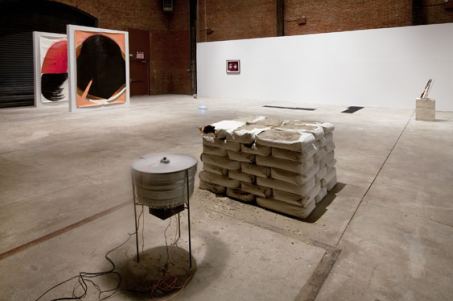SculptureCenter curator Fionn Meade took the title of his current exhibition, Leopards in the Temple, from a story by Franz Kafka that reads in its entirety:
Leopards break into the temple and drink to the dregs what is in the
sacrificial pitchers; this is repeated over and over again; finally it
can be calculated in advance, and it becomes a part of the ceremony.
In his review, Ken Johnson praised what he took to be Meade’s refreshingly modest claims for the artists in his survey:
Fionn Meade, the show’s organizer and the SculptureCenter’s curator,
says in an essay that he is under no illusions about which kind of cat
he’s wrangling. The artists he has picked, he writes, “return to
distinct formal vocabularies and art historical trajectories,” and they
are intent on “borrowing and unsettling rather than wholesale attempts
at either remaking or deconstructing.” In other words, while working
with familiar elements of style they mix and match their sources of
inspiration in new but not shockingly novel ways.Mr. Meade is describing the essence of contemporary academicism, and
while he puts a positive spin on this, it could be read as a
devastating critique. These are not the bestial vandals so beloved by
myth makers of the modern. It’s rare for a curator to assess his
artists in such honest terms, and in a sense Mr. Meade is operating in
the gap between curator and critic. At a time when curators too often
function more like smooth-talking hucksters than independent
intellectuals, that is good and refreshing.
Meade’s claims are only modest for those who still accept a modernist trajectory that peaks with destructive originals. Behind these tigers trail house-broken copycats, footnotes in someone else’s story.
But what if the artists in Meade’s show do not seek to despoil new frontiers but instead chose to acknowledge that the ground on which they stand is occupied? What if they want to make art out of an old ceremony rather than create a new one? What if their aim is not to shock but to unify? What if, in other words, they are not academics of old struggles but pioneers in new harmonies, ones with roots in the chaos of old scores?
Installation view, Leopards in the Temple:
 Meade comes from Seattle, where Ezra Pound’s injunction to “Make it new” matters less than E. M. Forster’s “Only connect.”
Meade comes from Seattle, where Ezra Pound’s injunction to “Make it new” matters less than E. M. Forster’s “Only connect.”
The artist statement of an exhibit at Tacoma’s now defunct Helm Gallery, Second Peoples, is worth quoting in full:
We have coined the name ‘second peoples’ to describe the people who
arrive late on the scene, after the beginning, after the abundance,
after the traumatic event, after everything’s been said and done,
after, even, the end. We are the second peoples. Chances are, you are
too.This is an exhibition dealing with what it means to be second. We
inhabit a landscape of iteration, reverb, elision, and generational
noise. Our corner of North America-these mountains, that timber, this
rich land-belonged to someone else. Our popular culture-those TV shows,
that movie sequel, this new band that is so retro they’re cool-belonged
to some other time. Our art is that way, too: this gesture to Donald
Judd, that nod to Philip Guston, that Eva Hesse wink.We are interested in locating the coordinates of this second position.
How did we end up here? What is our responsibility for what happened
before us? What is our responsibility for the things that happen now in
our names? Like Simone de Beauvoir argues in “Second Sex”, we think we
should be free to transcend ourselves as subjects, to not be confined
to existential leftovers.Contemporary art is concerned with this alchemy, trying to turn
second-handedness into first-handedness, reversing the flow of energy,
presenting not representing, creating value from valuelessness. We
think this is a worthwhile activity. We also think it is a fraught
activity. The work in this exhibition exposes some of the fractures
created by this ceaseless turning, and also dreams of a third position,
a reification of our desire to escape, a momentary place to stop.
Johnson again, about Meade’s show:
No one here, however, is likely to topple the current regime of art,
and in that respect these artists stand for the majority of
contemporary strivers. They are resourceful, alert and eager to please,
but are not wildly imaginative. Call them the mild ones.
Note the verb topple. Artists need not make war on their predecessors to qualify as major. Back in the 14th Century, Chaucer cast tributes behind him: “Out of old fields comes all the new corn.”



Both at once, Regina, and everything inbetween.